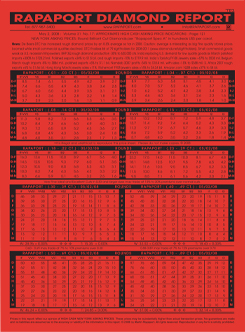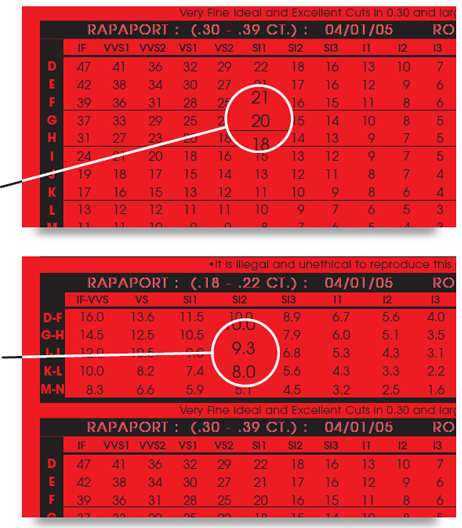Introduction to the Rapaport Price List
 The Rapaport price list is the primary source of
diamond price information for the diamond trade and is commonly used by dealers
as an approximate guideline for evaluating diamond prices. It is published online
every midnight Thursday. The Rapaport price list is the primary source of
diamond price information for the diamond trade and is commonly used by dealers
as an approximate guideline for evaluating diamond prices. It is published online
every midnight Thursday.
The Price Lists quote the Rapaport opinion of high cash asking prices for Rapaport
Specification A3 and better diamonds. Click here for more
information on Rapaport Specifications. These prices may be substantially
higher than actual transaction prices. It is most common for the diamond trade to
transact diamonds at a discount to the List. However, in some instances, select
qualities that are in short supply or subject to speculative demand may trade at
significant premiums to the List. Premiums, when applicable, are most common for
large, very fine cut diamonds.
The level of discount or premium varies greatly and is influenced by many factors.
Stone quality and cut, credit/memo terms, the location and type of market and the
liquidity level of particular size/quality combinations all impact the discount
level. Liquidity and the associated risk of ownership are also a factor. The easier
it is to sell a diamond, the lower its discounts to the List. Hard-to-sell diamonds
often trade at large discounts. Very in-demand, scarce diamonds may trade at premiums
to the List.
The Rapaport Price List does not provide transaction prices but rather price indications
that may serve as a starting point for negotiations and a basis for estimating value
for a broad range of diamond sizes and qualities. Transaction prices are the result
of negotiations between buyer and seller and reflect numerous factors, including
the physical characteristics of specific diamonds, terms of condition of sale, service
to customer and a host of other factors. Transaction prices may be substantially
higher or lower than list prices. Buyers and sellers are advised to consult with
experts before trading diamonds.
How to Read the Rapaport Price List
 The example
shown here is an excerpt from the Round Rapaport Price List dated April 1, 2005.
Each size range of diamonds has its own price grid matrix. For smaller sizes under
0.30 carat, the price grids refer to parcels of diamonds with color and clarity
ranges. For stones larger than 0.30, each color/clarity combination has a price.
All prices are in hundreds of U.S. dollars per carat. The example
shown here is an excerpt from the Round Rapaport Price List dated April 1, 2005.
Each size range of diamonds has its own price grid matrix. For smaller sizes under
0.30 carat, the price grids refer to parcels of diamonds with color and clarity
ranges. For stones larger than 0.30, each color/clarity combination has a price.
All prices are in hundreds of U.S. dollars per carat.
SINGLE STONE PRICES
To locate the price for a 0.34 carat H VS2, first select the 0.30 to 0.39 size matrix.
Find the H row and then locate the VS2 column. The number is 18, or $1,800 per carat.
The stone's price is 0.34 x $1,800 or $612 for the stone. Similarly, the price for
a 0.39 K VS1 is 13 or $1,300 per carat, or $507 per stone. If the stone sold at
a 25 percent discount, its price per carat would be $1,300 x 0.75 = $975/ct. and
the price per stone, $975 x 0.39 ct. = $380.25.
PARCEL PRICES
To locate the per-carat price for a parcel of 0.18 to 0.22 carat diamonds with an
average color of I-J and clarity SI2, select the 0.18 to 0.22 carat size matrix.
The I-J row and SI2 column show 8.0 or $800 per carat. The value of the parcel would
be the carat weight of the parcel times $800.
MIXED PARCELS
Consider a parcel of 0.30 to 0.39 carat diamonds that average F to G color and VVS1
to VVS2 clarity. Given the FVVS1 price of 36 ($3,600 per carat) and the G-VVS2 price
of 29 ($2,900 per carat), the average price is calculated at 32.5 or $3,250 per
carat. This approach works well based on the general principle that the Price List
should be used as an indicator of value and not as a final price.
Click here for even more information about the Rapaport
price list
The Rupee Price List
The Rupee Price List is published every Thursday along with the Rapaport Price List
in Dollars. It is a conversion of the Rapaport Price List in Dollars based on the
Thursday exchange rate from the Reserve Bank of India. Prices on the Rupee Price
List are rounded to thousands of Rupees.
|